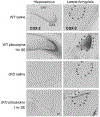The COX-2/prostanoid signaling cascades in seizure disorders
- PMID: 30484341
- PMCID: PMC6481174
- DOI: 10.1080/14728222.2019.1554056
The COX-2/prostanoid signaling cascades in seizure disorders
Abstract
Introduction:A robust neuroinflammatory response is a prevalent feature of multiple neurological disorders, including epilepsy and acute status epilepticus. One component of this neuroinflammatory reaction is the induction of cyclooxygenase-2 (COX-2), synthesis of several prostaglandins and endocannabinoid metabolites, and subsequent activation of prostaglandin and related receptors. Neuroinflammation mediated by COX-2 and its downstream effectors has received considerable attention as a potential target class to ameliorate the deleterious consequences of neurological injury. Areas covered: Here we describe the roles of COX-2 as a major inflammatory mediator. In addition, we discuss the receptors for prostanoids PGE2, prostaglandin D2, and PGF2α as potential therapeutic targets for inflammation-driven diseases. The consequences of prostanoid receptor activation after seizure activity are discussed with an emphasis on the utilization of small molecules to modulate prostanoid receptor activity. Expert opinion: Limited clinical trial experience is supportive but not definitive for a role of the COX signaling cascade in epileptogenesis. The cardiotoxicity associated with chronic coxib use, and the expectation that COX-2 inhibition will influence the levels of endocannabinoids, leukotrienes, and lipoxins as well as the prostaglandins and their endocannabinoid metabolite analogs, is shifting attention toward downstream synthases and receptors that mediate inflammation in the brain.
Keywords: Cyclooxygenase-2; EP1; EP2; NSAID; endocannabinoid; epilepsy; epileptogenesis; prostaglandins; seizures.
Conflict of interest statement
Declaration of interest
The authors have no other relevant affiliations or financial involvement with any organization or entity with a financial interest in or financial conflict with the subject matter or materials discussed in the manuscript. This includes employment, consultancies, honoraria, stock ownership or options, expert testimony, grants or patents received or pending, or royalties.
Figures




References
-
- DeWitt DL. Cox-2-selective inhibitors: the new super aspirins. Mol Pharmacol. 1999;55(4):625–31. Epub 1999/04/01. - PubMed
Publication types
MeSH terms
Substances
Grants and funding
LinkOut - more resources
Full Text Sources
Medical
Research Materials
